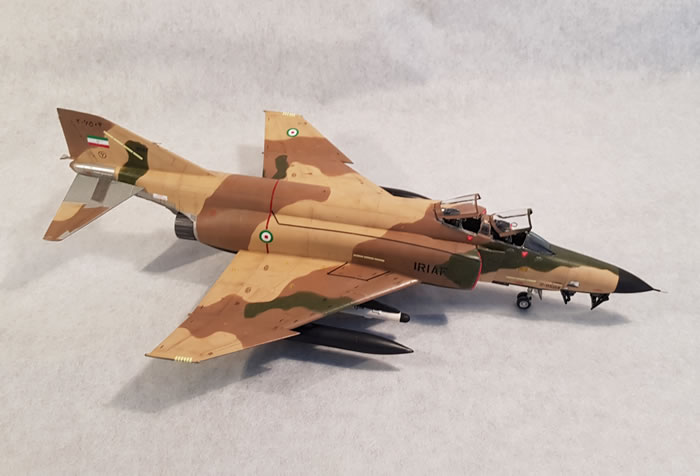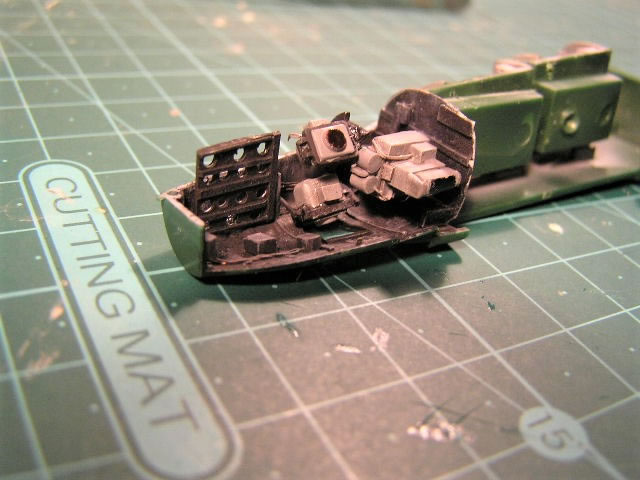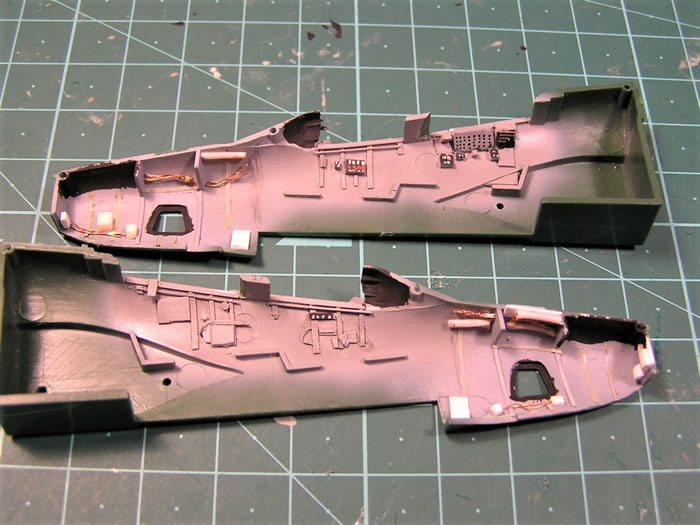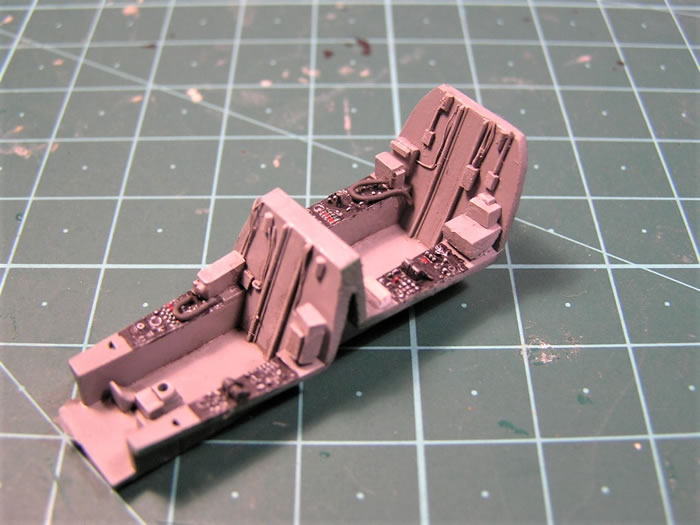Revell's 1/72 scale
McDonnell Douglas
RF-4E Phantom II
by Fernando Rolandelli
|
McDonnell Douglas RF-4E
Islamic Republic of Iran AF, 1980 |

Hobby Boss' 1/48 FM-1 Wildcat is available online from Squadron for only $27.99!
Background
(excerpts from J. Baugher site)
The RF-4C (Model 98DF) was the unarmed photographic reconnaissance version of the USAF's F-4C. The armament and radar of the fighter version was removed and replaced with equipment specialized for photographic reconnaissance.
The RF-4C had three camera stations in the nose. The Forward camera station (situated just behind the radar) could carry a single forward oblique or vertical KS-87 camera. Behind that, in the number 2 or "Low Altitude" station, a KA-56 low-altitude camera could be carried, although this could be replaced by a trio of vertical, left, and right oblique KS-87 cameras. Alternatively, a left or right oblique KS-87 could be carried in this station. A vertical KA-1 could be carried in the low-altitude station instead of the KS-87, or a KS-72 could replace a KS-87 in the 30-degree oblique position. The third station (the "High Altitude" station) was just ahead of the cockpit under the nose, and normally carried a single KA-55A or KA-91 high-altitude panoramic camera in a stabilized mount. Alternatively, two split vertical KS-87 cameras could be carried there, or KC-1 or T-11 mapping cameras could be installed. The High Altitude station could also house an AN/AVD-2 laser reconnaissance set, but this was later withdrawn from use.

An AN/AAD-5 or AN/AAS-18 infrared detection set was installed just aft of the nose wheel bay. The RF-4C is also fitted with a Goodyear AN/APQ-102 side-looking mapping radar, with antennae on either side of the lower nose just aft of the optical reconnaissance bay
Initially, the RF-4C carried no weapons, but in later years, RF-4Cs were armed with AIM-9 Sidewinder missiles carried on the inner underwing pylon for self-defense. Provision was also made for carrying an electronic countermeasures pod on the inboard pylon underneath the starboard wing.
Regarding Iranian RF-4Es, After Germany, Iran was the largest customer for the RF-4E, a unarmed reconnaissance version of the F-4E built strictly for export. A total of 27 examples were ordered by Iran. The first RF-4E destined for Iran rolled off the production line at McDonnell in St Louis in the late fall of 1970. The first RF-4Es arrived in Iran in 1971. Fifteen more RF-4Es were delivered in succeeding years. However, the final 11 RF-4Es destined for Iran were cancelled in February of 1979 for political reasons after the fall of the Shah. The machines performed valuable service during the Iran-Iraq war, with several shot down. Most probably, no RF made into the nineties in serviceable condition.
The Kit
I used the (then) widely available Revell AG kit, which I could get for change at toy stores while deployed to Germany. The decals in nowadays boxings depict cheesy anniversary schemes, so I got a Hi-decal sheet for USAF and international machines. I selected this particular one because it had the “square nose” (the only one provided in Revell kits) and the strange looking Black undersurfaces.
My aim in this build was to depict the camera bay, which the kit provides in embryo form (the basic shapes of three cameras) This, however, is much more than the otherwise fine Hasegawa kit offers.
I performed quite a bit of scratchbuilding there, as can be seen in the relevant pictures, aided by some good pictures in several references.

Then, I went to work on the cockpit, using some Eduard’s prepainted instrument panels combined to some scratchbuilding.

A mandatory Airwaves set for the canopy hoods’ rails was also commandeered.

I also detailed the wheel bays by some more scratchbuilding.
I shunned from doing anything on the insides of the intakes and truking, the former work proved tiresome; but I scratchbuilt some FOD guards using the Eduard PE set as a guide.
I detailed the exhaust with some tape “petals” after a seemingly cunning scheme to replace them by B-58 cans failed.
These things were unarmed, but I found some ECM pods in a Hasegawa box (an ALQ-87 and an ALQ-101) that could be suitable for that timeframe.
Paint
The Middle East Scheme of FS34079/30140/20400 really pays… if you can find these two latter colours! I used a Xtracolor for the Tan Special and added some drops of Red and Black to a 30219 for the Brown Special. The Black posed no problems! The finish was “weathered” by repeatedly lightening the colors and mottling them over and over; finally a diluted dark concoction was applied to dirty the look. The kit was glossed with Xtracrylix varnish, handbrushed; after decals were applied, an artist’s Flat acrylic varnish sealed the model.
Decals
The decals came from a Hi-Decal sheet and performed very well, being thin and well proportioned.
I messed one of the numbers in Farsi, but no one would notice it.
Revell Phantoms are good builds. They are keyed specifically to German Phantoms: that´s apparent in the armament. They have a couple of shape problems: the canopy contour looks a bit shallow, the tip of the fin too canted and the sit of the model is a bit “nose down”. In this particular one, I had a nightmarish time trying to fair the intakes, but it was surely my own carelessness. However, they are good, honest, well detailed kits that render a nice model OOB, though probably improving them is a bit laborious.
References
- “Phantom Units of the Iran-Iraq War”, Fazad Bishop, Tom Cooper, Osprey Publishing
- Detail and Scale 007 - F-4 Phantom part 2 - F-4E/G In detail and scale - Bert Kinzey
- Air Vanguard 007 - USAF Mc Donnell Douglas Phantom II - Peter Davies - Osprey publishing
- Squadron In Action n° 65 - Squadron Signal publications
- “The F-4 Phantom Part I: USAF versions”, Andy Evans. SAMI Publications.
Text and Images Copyright ©
2020 by Fernado Rolandelli
Page Created 31 March, 2020
Last Updated
1 April, 2020
Back to HyperScale Main Page
|
Home
| What's New | Features | Gallery | Reviews | Reference | Resource Guides | Forum |